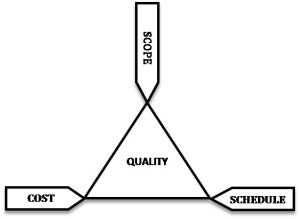What is project management?
Organising work into projects
What is project management? In order to start project management we first need a project. A project is something which will bring about change in some way, or something that has a defined beginning and ends when a desired goal is reached. This could be developed into a more complex definition that a project is something that is planned or devised or an important undertaking, which may involve considerable organisation, expense, resources, personnel, and equipment.
Definition: Project Management is the coordination and application of activities to successfully complete the project objectives.
Every project has a set of objectives, usually and preferably formal, which are necessary to complete the project. For example a project to start a new airline might involve the following objectives:
- Find a suitable site for company headquarters
- Buy or lease the site
- Find, recruit and train professional staff to run the airline
- Choose flights and routes to operate
- Find and lease or buy hangars
- Purchase or lease aeroplanes to operate on the routes
- Find, recruit and train technical staff to maintain the aeroplanes
- Secure supplies of food, fuel and supplies to operate the aeroplanes
- Draw up a flight timetable
- Finalise legal and regulatory matters relating to civil aviation
- Launch the airline with suitable publicity
The above is simplistic but shows how a project is broken down into various groups of tasks and objectives. All need to be completed and in a specific order for the project to be successful. For example a flight timetable cannot be drawn up until routes have been agreed.
Projects usually have both budgets and timetables and with many projects both of these are critical. For example an airport runway project that overruns its timetable may disrupt other projects by airlines to expand their number of flights. Often projects are dependant on each other. For many organisations and individuals life and existence can be viewed as a series of projects.
The Project Management ‘Golden Triangle’.

A powerful way to see projects is to use the ‘Project Golden Triangle’ analogy. As can be seen from the diagram on the left, projects have 3 dimensions: cost, scope and schedule. Each of these 3 things affects the two others. So for example if you increase the scope of a project i.e. add more things into it, you will affect the schedule – it will take longer – and you will affect the cost – it will cost more. You might choose to increase scope but keep the original schedule, in which case you will have to take on more staff to deliver the project on time, so the cost dimension is affected. But you definitely cannot change one of the dimensions without impacting on the others.
Contrary to what is sometimes said ‘Agile’ project management is also part of the golden triangle, but for example in many agile projects there is a schedule of steps where something must be delivered, so care has to be taken to limit the scope and cost for each part of the schedule.
In more traditional ‘deliver everything in a big bang’ approaches to project management, scope and schedule tend to be constrained, which explains the cost overruns which are common. For example large government projects tend to be plagued by such overruns.
Professional project managers say that each project has the following features:
- Its purpose
- Requirements which it has to deliver
- Deliverables – what the project will deliver
- Estimated timetable
- Estimated budget
- Estimated resources – this includes people who will carry out the work
- A usually formal justification often in the form of a business plan
- Agreement to proceed with the resources, timetable and budget
- A project plan which foresees how the project will proceed, where and when
- A project team who will deliver the project or oversee those who deliver, with clear responsibilities for each member
- A risk assessment of risks posed by the project if it is successful or fails
- Agreed metrics to monitor the progress of the project against the plan
Monitoring of the project budget
Project stakeholders – those who will gain from the completion of the project and may have initiated it Project closure – this includes the formal agreement or ‘signing off’ of the project if successful or any criteria by which it may be terminated uncompleted
When to start projects
A project is required when there is an objective to be achieved which is best achieved as a separate series of tasks outside of day to day work.